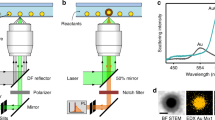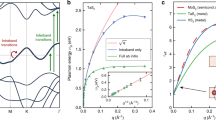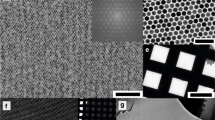Abstract
Surface plasmon (SP) excitations in metals facilitate confinement of light into deep-subwavelength volumes and can induce strong light–matter interaction1,2. Generally, the SP resonances supported by noble metal nanostructures are explained well by classical models, at least until the nanostructure size is decreased to a few nanometres, approaching the Fermi wavelength λF of the electrons3,4,5,6. Although there is a long history of reports on quantum size effects in the plasmonic response of nanometre-sized metal particles7,8,9,10,11,12, systematic experimental studies have been hindered by inhomogeneous broadening in ensemble measurements3, as well as imperfect control over size, shape, faceting, surface reconstructions13, contamination14, charging effects15 and surface roughness16 in single-particle measurements. In particular, observation of the quantum size effect in metallic films and its tuning with thickness has been challenging as they only confine carriers in one direction. Here, we show active tuning of quantum size effects in SP resonances supported by a 20-nm-thick metallic film of indium tin oxide (ITO), a plasmonic material serving as a low-carrier-density Drude metal17,18,19,20,21. An ionic liquid (IL)22,23 is used to electrically gate and partially deplete the ITO layer. The experiment shows a controllable and reversible blue-shift in the SP resonance above a critical voltage. A quantum-mechanical model including the quantum size effect reproduces the experimental results, whereas a classical model only predicts a red shift.
This is a preview of subscription content, access via your institution
Access options
Access Nature and 54 other Nature Portfolio journals
Get Nature+, our best-value online-access subscription
$29.99 / 30 days
cancel any time
Subscribe to this journal
Receive 12 print issues and online access
$259.00 per year
only $21.58 per issue
Buy this article
- Purchase on Springer Link
- Instant access to full article PDF
Prices may be subject to local taxes which are calculated during checkout



Similar content being viewed by others
References
Schuller, J. A. et al. Plasmonics for extreme light concentration and manipulation. Nat. Mater. 9, 193–204 (2010).
Anker, J. N. et al. Biosensing with plasmonic nanosensors. Nat. Mater. 7, 442–453 (2008).
Kreibig, U. & Genzel, L. Optical absorption of small metallic particles. Surf. Sci. 156, 678–700 (1985).
Ciracì, C. et al. Probing the ultimate limits of plasmonic enhancement. Science 337, 1072–1074 (2012).
Savage, K. J. et al. Revealing the quantum regime in tunnelling plasmonics. Nature 491, 574–577 (2012).
Toscano, G. et al. Resonance shifts and spill-out effects in self-consistent hydrodynamic nanoplasmonics. Nat. Commun. 6, 7132 (2015).
Wood, D. M. & Ashcroft, N. W. Quantum size effects in the optical properties of small metallic particles. Phys. Rev. B 25, 6255–6274 (1982).
Halperin, W. Quantum size effects in metal particles. Rev. Mod. Phys. 58, 533–606 (1986).
Keller, O., Xiao, M. & Bozhevolnyi, S. Optical diamagnetic polarizability of a mesoscopic metallic sphere: transverse self-field approach. Opt. Commun. 102, 238–244 (1993).
Scholl, J. A., Koh, A. L. & Dionne, J. A. Quantum plasmon resonances of individual metallic nanoparticles. Nature 483, 421–427 (2012).
Raza, S. et al. Blueshift of the surface plasmon resonance in silver nanoparticles studied with EELS. Nanophotonics 2, 131–138 (2013).
Tiggesbaumker, J., Koller, L. & Liebsch, A. Blueshift of the Mie plasma frequency in Ag clusters and particles. Phys. Rev. A 48, R1749–R1752 (1993).
Kolb, D. M. Reconstruction phenomena at metal-electrolyte interfaces. Prog. Surf. Sci. 51, 109–173 (1996).
Dondapati, S. K. et al. Voltage-induced adsorbate damping of single gold nanorod plasmons in aqueous solution. Nano Lett. 12, 1247–1252 (2012).
Novo, C., Funston, A. M., Gooding, A. K. & Mulvaney, P. Electrochemical charging of single gold nanorods. J. Am. Chem. Soc. 131, 14664–14666 (2009).
Vernon, K. C. et al. Influence of particle-substrate interaction on localized plasmon resonances. Nano Lett. 10, 2080–2086 (2010).
Boltasseva, A. & Atwater, H. A. Low-loss plasmonic metamaterials. Science 331, 290–291 (2011).
Feigenbaum, E., Diest, K. & Atwater, H. A. Unity-order index change in transparent conducting oxides at visible frequencies. Nano Lett. 10, 2111–2116 (2010).
Franzen, S. et al. Plasmonic phenomena in indium tin oxide and ITO-Au hybrid films. Opt. Lett. 34, 2867–2869 (2009).
Liu, X. et al. Quantification and impact of nonparabolicity of the conduction band of indium tin oxide on its plasmonic properties. Appl. Phys. Lett. 105, 181117 (2014).
Losego, M. D. et al. Conductive oxide thin films: model systems for understanding and controlling surface plasmon resonance. J. Appl. Phys. 106, 24903 (2009).
Misra, R., McCarthy, M. & Hebard, A. F. Electric field gating with ionic liquids. Appl. Phys. Lett. 90, 2005–2008 (2007).
Ueno, K. et al. Discovery of superconductivity in KTaO3 by electrostatic carrier doping. Nat. Nanotech. 6, 408–412 (2011).
Gleiter, H., Weissmüller, J., Wollersheim, O. & Würschum, R. Nanocrystalline materials: a way to solids with tunable electronic structures and properties? Acta Mater. 49, 737–745 (2001).
Sagmeister, M., Brossmann, U., Landgraf, S. & Würschum, R. Electrically tunable resistance of a metal. Phys. Rev. Lett. 96, 10–14 (2006).
Rodrigo, D. et al. Mid-infrared plasmonic biosensing with graphene. Science 349, 165–168 (2015).
Park, J. et al. Electrically tunable epsilon-near-zero (ENZ) metafilm absorbers. Sci. Rep. 5, 15754 (2015).
Vasudev, A. P., Kang, J.-H., Park, J., Liu, X. & Brongersma, M. L. Electro-optical modulation of a silicon waveguide with an ‘epsilon-near-zero’ material. Opt. Express 21, 26387–26397 (2013).
Kötz, R., Kolb, D. M. & Sass, J . Electron density effects in surface plasmon excitation on silver and gold electrodes. Surf. Sci. 69, 359–364 (1977).
Yuan, H. et al. Hydrogenation-induced surface polarity recognition and proton memory behavior at protic-ionic-liquid/oxide electric-double-layer interfaces. J. Am. Chem. Soc. 132, 6672–6678 (2010).
Teich, W. G. & Mahler, G. Plasmon excitations in thin metal films. Phys. Status Solidi 138, 607–620 (1986).
Laref, S. et al. Size-dependent permittivity and intrinsic optical anisotropy of nanometric gold thin films: a density functional theory study. Opt. Express 21, 11827–11838 (2013).
West, P. R. et al. Searching for better plasmonic materials. Laser Photon. Rev. 4, 795–808 (2010).
De Leon, N. P., Lukin, M. D. & Park, H. Quantum plasmonic circuits. IEEE J. Sel. Top. Quantum Electron. 18, 1781–1791 (2012).
Tame, M. S. et al. Quantum plasmonics. Nat. Phys. 9, 329–340 (2013).
Acknowledgements
This work was supported by the Extreme Electron Concentration Devices (EXEDE) MURI program of the Office of Naval Research (ONR) through grant no. N00014-12-1-0976. H.T.Y. and Y.C. acknowledge support by the Department of Energy, Office of Basic Energy Sciences, Division of Materials Sciences and Engineering, under contract DE-AC02-76SF00515.
Author information
Authors and Affiliations
Contributions
X.L., J.-H.K. and M.L.B. conceived the ideas for this research project. X.L. and J.-H.K. developed the condition for the ITO layer deposition and fabricated the sample. X.L. annealed the sample for carrier concentration control of ITO. H.T.Y., Y.C. and H.Y.H. contributed to the IL gating. J.-H.K., X.L. and S.J.K. carried out the optical experiments. X.L. developed the quantum confinement model and performed the calculation. J.-H.K., J.P. and X.L. developed the transfer matrix method calculation. X.L., J.-H.K. and M.L.B. wrote the manuscript. M.L.B. supervised the project. All authors discussed the manuscript and agreed on its final content.
Corresponding authors
Ethics declarations
Competing interests
The authors declare no competing financial interests.
Supplementary information
Supplementary information
Supplementary information (PDF 1653 kb)
Rights and permissions
About this article
Cite this article
Liu, X., Kang, JH., Yuan, H. et al. Electrical tuning of a quantum plasmonic resonance. Nature Nanotech 12, 866–870 (2017). https://doi.org/10.1038/nnano.2017.103
Received:
Accepted:
Published:
Issue Date:
DOI: https://doi.org/10.1038/nnano.2017.103
This article is cited by
-
Nanoscale modeling of dynamically tunable planar optical absorbers utilizing InAs and InSb in metal-oxide-semiconductor–metal configurations
Discover Nano (2023)
-
Upshifting potentials to increase reversibility
Nature Energy (2022)
-
Surface plasmon induced spot and line formation at interfaces of ITO coated LiNbO3 slabs and gigantic nonlinearity
Scientific Reports (2021)
-
Ultra-broadband spatial light modulation with dual-resonance coupled epsilon-near-zero materials
Nano Research (2021)
-
Extreme nanophotonics from ultrathin metallic gaps
Nature Materials (2019)



